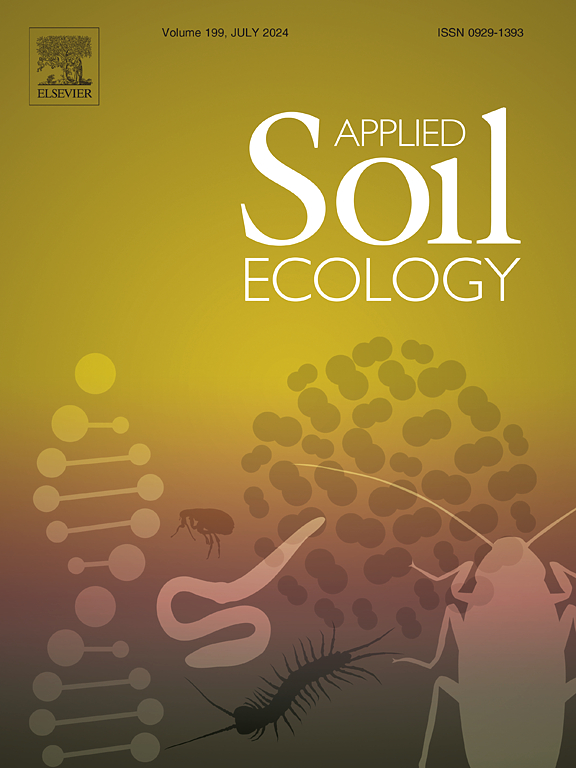Dose-dependent responses of N2O emissions to biodegradable microplastics and warming in contrasting subtropical soils of Southwest China
IF 5
2区 农林科学
Q1 SOIL SCIENCE
引用次数: 0
Abstract
Microplastic pollution and climate change are increasingly recognized as key drivers of biogeochemical processes in soil ecosystems, however, their interactive effects on greenhouse gas (GHG) emissions remain poorly understood. Here, we conducted a 168-h laboratory incubation. We used two contrasting subtropical soils from the karst region of Southwest China: a natural Masson pine (Pinus massoniana) forest soil and an adjacent farmland soil converted from the same forest and continuously cultivated with chili (Capsicum annuum) for two decades. Treatments included biodegradable polylactic acid (PLA) microplastics at 0 %, 1 %, and 10 % (w/w) and two temperatures (25 and 30 °C). Incubations were run under oxic (20 % O2) and anoxic (0 % O2) conditions. Soil analyses and quantitative PCR conducted prior to incubation revealed that farmland soils had higher NO3− (+229 %) and NH4+ (+45 %) concentration, enzymatic activity (β-1,4-N-acetyl-glucosaminidase: +16 %, β-1,4-glucosidase: +15 %), microbial Simpson diversity (+8 %), and lower DOC concentration (−64 %) compared to forest soils. Additionally, farmland soil had significantly higher abundances of denitrification-related functional genes (+2 %–7 %) and lower ammonia-oxidizing bacteria (amoA-AOB, −2 %). These changes potential strongly promoted cumulative CO2 (+18 %) and N2O (+384 %) emissions in farmland soils (CO2: 133 ± 16 g C kg−1, N2O: 94 ± 19 mg N kg−1) compared to natural forest. CO2 emissions showed additive effects, with maximum CO2 emissions under 10 % w/w PLA at 30 °C. Interestingly, a nonlinear response in N2O emission was observed: emissions peaked at 1 % PLA (53 ± 11 mg N kg−1) but declined at 10 % (16 ± 4 mg N kg−1), suggesting a concentration threshold potentially due to microbial priming at low PLA and substrate limitation at higher doses. Our results state that forest-to-farmland conversion substantially increases CO2 and N2O emissions due to elevated inorganic nitrogen and denitrifier gene abundance. Moreover, we reveal a threshold effect of microplastics on N2O fluxes and a synergistic effect of warming and microplastics on CO2, but not N2O, emission. These results highlight the need to consider land use history, pollutant concentration, and gas-specific microbial pathways when predicting soil GHG responses under future climate scenarios. However, these insights are based on short-term incubation, and further long-term studies are required to validate whether these patterns persist or shift over extended exposure.
西南亚热带土壤N2O排放对可生物降解微塑料和变暖的剂量依赖性响应
微塑料污染和气候变化日益被认为是土壤生态系统生物地球化学过程的关键驱动因素,然而,它们对温室气体(GHG)排放的相互作用仍知之甚少。在这里,我们进行了168小时的实验室孵育。我们使用了来自中国西南喀斯特地区的两种不同的亚热带土壤:一种是天然马尾松(Pinus massoniana)森林土壤,另一种是相邻的农田土壤,由同一森林转化而来,连续种植辣椒(Capsicum annuum) 20年。处理包括0%、1%和10% (w/w)的可生物降解聚乳酸(PLA)微塑料,两种温度(25和30℃)。在有氧(20% O2)和无氧(0% O2)条件下进行培养。培养前的土壤分析和定量PCR表明,与森林土壤相比,农田土壤具有更高的NO3−(+ 229%)和NH4+(+ 45%)浓度,酶活性(β-1,4- n -乙酰氨基葡萄糖苷酶:+ 16%,β-1,4-葡萄糖苷酶:+ 15%),微生物Simpson多样性(+ 8%)和更低的DOC浓度(- 64%)。此外,农田土壤反硝化相关功能基因丰度显著增加(+ 2% - 7%),氨氧化细菌(amoA-AOB)丰度显著降低(- 2%)。与天然林相比,这些变化潜力强烈促进了农田土壤(CO2: 133±16 g C kg - 1, N2O: 94±19 mg N kg - 1)累积CO2(+ 18%)和N2O(+ 384%)排放。CO2排放量表现出加性效应,在30°C下,当PLA含量为10% w/w时,CO2排放量最大。有趣的是,在N2O排放中观察到非线性响应:排放量在1% PLA(53±11 mg N kg - 1)时达到峰值,但在10%(16±4 mg N kg - 1)时下降,这表明浓度阈值可能是由于低PLA时的微生物引发和高剂量时的底物限制。我们的研究结果表明,由于无机氮和反硝化基因丰度的增加,森林到农田的转换大大增加了CO2和N2O的排放。此外,我们揭示了微塑料对N2O通量的阈值效应,以及升温和微塑料对CO2(而非N2O)排放的协同效应。这些结果强调,在预测未来气候情景下土壤温室气体响应时,需要考虑土地利用历史、污染物浓度和特定气体的微生物途径。然而,这些见解是基于短期的孵化,需要进一步的长期研究来验证这些模式是持续存在还是随着暴露时间的延长而改变。
本文章由计算机程序翻译,如有差异,请以英文原文为准。
求助全文
约1分钟内获得全文
求助全文
来源期刊

Applied Soil Ecology
农林科学-土壤科学
CiteScore
9.70
自引率
4.20%
发文量
363
审稿时长
5.3 months
期刊介绍:
Applied Soil Ecology addresses the role of soil organisms and their interactions in relation to: sustainability and productivity, nutrient cycling and other soil processes, the maintenance of soil functions, the impact of human activities on soil ecosystems and bio(techno)logical control of soil-inhabiting pests, diseases and weeds.
 求助内容:
求助内容: 应助结果提醒方式:
应助结果提醒方式:


